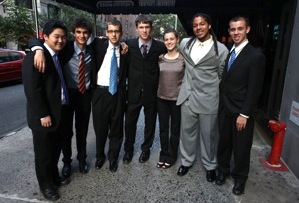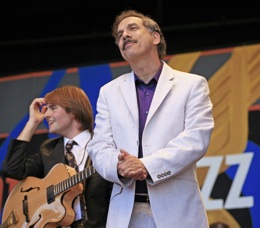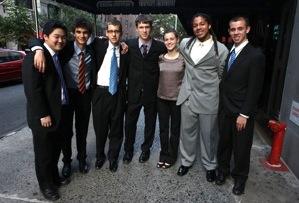It’s not just about the big names. When the 53rd Monterey Jazz Festival swings into action on Friday, Sept. 17, ten gifted high school–age ensembles will feature prominently on the grounds and main arena stages. Their appearances constitute but one aspect of a comprehensive jazz education program that includes a Summer Jazz Camp, traveling clinicians program, and annual Next Generation Festival.

Among the youth ensembles is the sensational Monterey Jazz Festival Next Generation Jazz Orchestra (aka “Next Gen”). Founded in 1971 as the MJF High School All-Star Big Band, it opens its ranks to gifted high schoolers from around the world.
This year’s 21-member Next Generation Jazz Orchestra includes six students from the Bay Area. Under the directorship of Paul Contos, they have already undertaken a whirlwind tour to Cleveland, Toronto, Montreal, and New York City. After standing ovations in Cleveland, they were bused to Toronto the next morning. With 90 minutes to set up, they played a smoking set straight through, jumped back on the bus, and headed to their next gig.
On Sept. 19 in Monterey, the Next Generation Jazz Orchestra shares the stage with the great vocalist Dianne Reeves. As they perform, some will have in mind the careers built by a host of Next Gen alums, among whom are pianists Benny Green and Patrice Rushen; bassist Larry Grenadier; drummer Chad Wackerman; saxophonists Joshua Redman, Eric Marienthal, and Dave Koz; trombonist Andy Martin; and Big Band leader Gordon Goodwin.

“One of the missions of the Next Gen Band is to celebrate some of the most cutting-edge repertoire that’s currently being written for jazz orchestra,” Contos explained in a conference call that also included four Bay Area members of the orchestra. “It’s really modern American classical music. While a lot of the arrangements showcase soloists in the band, the performances are really a celebration of the particular composers and arrangers. I spent months and months selecting the material, because I can’t present any Mickey Mouse repertoire to them. I am amazed that in the short rehearsal time, they can really whip it together.”
Equally important is to give what Contos calls “the best young jazz players in the nation” a nuts and bolts experience of what it’s like to be out on the road. For Jillian Ryan of Novato, the tour was a true trial by fire. Experiencing low energy from the start, she “barreled through and played great,” she remarked, only to return home to discover that she was suffering from mononucleosis.
“It’s all about the process,” Contos said. “The actual performance with Dianne Reeves is of course wonderful, but the chance to rehearse with her, talk about the music, and all that interaction [with her and the other band members] is the most fabulous part.”
Inequities and Higher Truths
Featured Video
The makeup of Next Gen in some ways reflects the inequities in American music education and practice. Although jazz has its roots in the American “Negro” experience, only one of this year’s members, drummer and recent Vista High School graduate Malachi Isaiah Whitson of Richmond, is African-American. An equal standout is Ryan, who is the only female. Versed in alto and soprano saxophone and flute, and a singer as well, she just graduated from the Marin School of the Arts.
Reflecting the fact that times have changed in some parts of the Bay Area, neither was troubled by their solo status. “Race is not an issue,” Whitson explained by cell phone. “In my greater opinion, this music is for everybody. I don’t nail it to one specific race. Music is music, and nothing should stop anyone from wanting to play. Music is for everybody.”
Following suit, Ryan declared, “I’ve gotten used to knowing that women are a minority in this music. I feel somewhat isolated, but I don’t really pay attention to the fact that I’m the only girl in this Next Gen thing, because it really isn’t about gender or race; it’s about how you’re playing.”
Nonetheless, Ryan is well-aware of her isolation. “It’s such a male-dominated style of music,” she said. “Women are known usually as being singers. There’s one other girl in my high school band. I may be the only girl in my high school who is serious [about a music career], but there are girls I’ve known who’ve gone on to the Manhattan School of Music or other places, and are really great jazz musicians. All I know is that I’d like to see more women playing jazz, singing, and kicking. It’s a strange thing that there aren’t more women, but I guess it’s just normal.”
Spreading His Wings
Whitson’s story is unusual. His parents are music majors who were far more versed in classical music and R&B than jazz. His mother and one of his uncles continued their music education through college, after which his mother received scholarships to continue her operatic voice studies in Germany.
As a large extended family, some of whose members grew up on welfare, the Whitson clan used music as the bond to keep them together. “When I was younger,” Whitson explained, “it was kinda a ritual in my family to figure out what the kid was going to play.”
He first began playing piano and guitar, but latched onto the drums early on. Although he claims to have first become immersed in jazz last year, he has already received the 2008/2009 “Outstanding Drummer” award from the Reno and Folsom jazz festivals, and another from the Heritage Festival in Canada. In 2009, he won the “Best Overall Musician” and “Best Drummer” awards at the San Jose Jazz Workshop, and the Eddie Moore Award at the Stanford Jazz Workshop.
This year, Whitson was a finalist in DownBeat magazine’s Composition Competition; won the East Bay Women in Action’s scholarship for Outstanding Steel Pan instructor; was the first recipient of SFJAZZ’s “Student Award for Excellence”; and was accepted into four summer jazz programs. Orchestra director Contos calls him “one of the best young drummers I’ve ever had the opportunity to work with.”
“I’m from the part of town that didn’t have jazz, part of the black experience that was neglected by the rest of the country,” said Whitson. “I want to pump more of this kind of music into these kinds of communities. I plan, when I become well off or financially stable, to come back and help my community in Richmond.”
Classical Foundations, Jazz Inspirations
Ryan, who began her music studies as a classical flautist, still has one foot in the classical camp. Between performances with the Marin Symphony Youth Orchestra, she has won soloist awards at the Santa Cruz, Folsom, and Reno jazz festivals, including Reno’s Outstanding Musicianship Soloist Award on saxophone.
“Both disciplines are challenging,” she remarked. “It’s intriguing, you’re forever learning, and it’s hard. But with classical music, from what I have learned and experienced, it was to a point predictable. A lot of jazz comes from classical music and composers such as Stravinsky and Debussy and Bartók, so I can’t really make that statement with certainty, because the two are intertwined. But for me, there aren’t as many boundaries in jazz. And the whole aspect of improvising isn’t on the same level in classical.”
Next Genner bass and tenor trombonist Chris Palowitch, who will enter his junior year at Amador Valley High School in Pleasanton, also loves jazz’s improvisational aspects. “I think there’s a lot more expression you can put into jazz music than you can into classical,” he said. “It’s a different kind of expression. Especially if you’re soloing, there’s so much you can do. There really aren’t any boundaries you have to stay in, exactly. And the music and sound of jazz appeal to me more than classical.”
Nonetheless, given the absence of a jazz trombonist to study with, he takes lessons from a classical teacher. “I pretty much need technique on my instrument, and classical training can give you a lot of that,” he says.
Another Next Gen member, trumpeter Benjamin Kreitman, who graduated from Henry M. Gunn High School in Palo Alto and has entered Columbia University as a political science major, took three years of classical instruction before moving on to a host of jazz ensembles.
“Instead of feeling I was tiptoeing around very well-defined restrictions in classical music, the freedom in jazz is what got me,” he said. “In jazz improvisation, you can create your own voice. That is something I want to explore. The thing about jazz that is most captivating for me is that I believe, at the core of music, the one rule you must abide by is: If it sounds good, then it’s being done correctly.”

